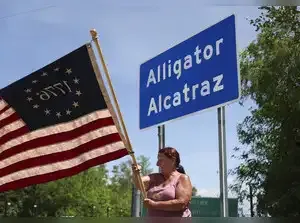Florida’s remote detention center in the Everglades—known widely as “Alligator Alcatraz”—is once again under the spotlight. Reports are mounting that hundreds of detainees who were once inside can no longer be traced. Families, lawyers, and immigrant advocates are sounding the alarm, warning that people appear to have simply disappeared from official records.
Alligator Alcatraz, a detention center built rapidly on a former airstrip in the Everglades and endorsed by President Donald Trump during its inauguration in early July 2025, has become known as a "black hole" in the immigration system.
The American Civil Liberties Union (ACLU) and immigrant advocacy groups highlight that detainees are effectively "off the radar," which obstructs due process and attorney-client communication. There have been multiple lawsuits against the facility, challenging Florida’s authority to detain immigrants there and raising issues of poor conditions and mistreatment.
Following a judge’s ruling to dismantle the camp, now stayed by an appeals court, the detainee population at Alligator Alcatraz has significantly decreased. State officials and DHS have stated the facility would soon be empty, with transfers to other centers and some deportations occurring. However, it is unclear how many detainees have been deported or transferred, and reports indicate pressure on detainees to sign voluntary deportations. Incidents such as accidental deportation of detainees have been reported, adding to the confusion.
The Department of Homeland Security claims detainees have opportunities to communicate with attorneys and family and that the number of detainees fluctuates due to deportations and transfers. Nevertheless, advocacy groups criticize ICE for not promptly updating detainee locations and maintaining transparency. The lack of clear information has caused distress among families and legal representatives, with some attorneys needing days to schedule visits.
At first, thousands were held inside—mothers, fathers, sons, daughters. Most had come from Latin America, many fleeing difficult lives only to find themselves surrounded by heat, humidity, and fences. Inside, stories filtered out: food shortages, drinking water complaints, medical care delays. Some told of cages packed wall to wall, with dozens of people called by number and not by name. The fear was constant—of storms, of illness, of never seeing family again.
But by late summer, almost as suddenly as it filled, the vast camp began to empty. Families waiting for news found the phone calls stopped. Online, the detainees’ names vanished without record. Mothers, fathers, and lawyers called but got no answers. Rumors spread that many had been deported, or shipped elsewhere, or released in secret. Nobody could say for sure. With no public lists and no paper trail, loved ones began asking: “Where did everyone go?”
For those stuck outside, the days grew tense and fearful. Family members described the agony of trying to learn whether loved ones were alive and safe, or even within U.S. borders anymore. Some feared the worst. Stories of medical emergencies, denied lawyer visits, and lost court dates made the uncertainty feel even more urgent.
Inside the complex, pressure mounted. Lawsuits accused the facility of violating the rights of detainees and risking lives with poor conditions. Judges weighed in, demanding ICE at least slow down the removals and provide more information. But appeals and bureaucratic delays pushed real answers further away. Meanwhile, buses kept rolling out of the swampland. Each departure brought a swirl of new questions.
What stands out, in the end, is how quickly lives can disappear from view. When records vanish and systems close their doors, real people are left searching for hope. The fate of those who passed through Alligator Alcatraz is still unknown to many families. Some attorneys say they may never know what happened to all of them.
This story isn’t just about one controversial building in the swamp. It’s about the ongoing struggle over borders, belonging, and basic human rights. What happens when the system loses track of people it was supposed to keep safe—no matter where they came from or why they came here? How long will families and advocates go on searching for answers that may never come?
This mystery, born in the isolation of the Everglades, now follows a trail across the nation—a trail faded by time, confusion, and silence. For those who care about justice, the next chapter is clear: the search must continue until every missing name is found, and every voice has the dignity to be heard.
Alligator Alcatraz, a detention center built rapidly on a former airstrip in the Everglades and endorsed by President Donald Trump during its inauguration in early July 2025, has become known as a "black hole" in the immigration system.
The American Civil Liberties Union (ACLU) and immigrant advocacy groups highlight that detainees are effectively "off the radar," which obstructs due process and attorney-client communication. There have been multiple lawsuits against the facility, challenging Florida’s authority to detain immigrants there and raising issues of poor conditions and mistreatment.
Following a judge’s ruling to dismantle the camp, now stayed by an appeals court, the detainee population at Alligator Alcatraz has significantly decreased. State officials and DHS have stated the facility would soon be empty, with transfers to other centers and some deportations occurring. However, it is unclear how many detainees have been deported or transferred, and reports indicate pressure on detainees to sign voluntary deportations. Incidents such as accidental deportation of detainees have been reported, adding to the confusion.
The Department of Homeland Security claims detainees have opportunities to communicate with attorneys and family and that the number of detainees fluctuates due to deportations and transfers. Nevertheless, advocacy groups criticize ICE for not promptly updating detainee locations and maintaining transparency. The lack of clear information has caused distress among families and legal representatives, with some attorneys needing days to schedule visits.
Why Did Immigrants Vanish from Alligator Alcatraz?
The story begins quietly, in the wild heart of the Florida Everglades. There, a new immigration detention center rose up almost overnight. Locals started calling it “Alligator Alcatraz.” Its official name hardly mattered. What people saw and heard mattered more.At first, thousands were held inside—mothers, fathers, sons, daughters. Most had come from Latin America, many fleeing difficult lives only to find themselves surrounded by heat, humidity, and fences. Inside, stories filtered out: food shortages, drinking water complaints, medical care delays. Some told of cages packed wall to wall, with dozens of people called by number and not by name. The fear was constant—of storms, of illness, of never seeing family again.
But by late summer, almost as suddenly as it filled, the vast camp began to empty. Families waiting for news found the phone calls stopped. Online, the detainees’ names vanished without record. Mothers, fathers, and lawyers called but got no answers. Rumors spread that many had been deported, or shipped elsewhere, or released in secret. Nobody could say for sure. With no public lists and no paper trail, loved ones began asking: “Where did everyone go?”
Searching for Answers in the Shadows
Even government officials struggled to explain. One week the center was bustling with nearly two thousand people; weeks later, that number dropped by more than half. Inquiries to agencies went in circles. Sometimes the official advice was simply, “Call back later.” Families camped out, hoping for word. Lawyers scrambled to track their clients. Human rights groups sounded alarms about disappearing people and secret removals. Was it a data glitch—or a deliberate blackout?For those stuck outside, the days grew tense and fearful. Family members described the agony of trying to learn whether loved ones were alive and safe, or even within U.S. borders anymore. Some feared the worst. Stories of medical emergencies, denied lawyer visits, and lost court dates made the uncertainty feel even more urgent.
Inside the complex, pressure mounted. Lawsuits accused the facility of violating the rights of detainees and risking lives with poor conditions. Judges weighed in, demanding ICE at least slow down the removals and provide more information. But appeals and bureaucratic delays pushed real answers further away. Meanwhile, buses kept rolling out of the swampland. Each departure brought a swirl of new questions.
What Next for Alligator Alcatraz—and Its Missing Detainees?
As the summer closed, officials announced the site would soon be empty. News crews showed up hoping for interviews. Protesters and faith leaders gathered at the gates, lighting candles for those lost in the shuffle. In courtrooms and city halls, debate raged over the future of detention in America and the growing number of people swept away by changes in policy.What stands out, in the end, is how quickly lives can disappear from view. When records vanish and systems close their doors, real people are left searching for hope. The fate of those who passed through Alligator Alcatraz is still unknown to many families. Some attorneys say they may never know what happened to all of them.
This story isn’t just about one controversial building in the swamp. It’s about the ongoing struggle over borders, belonging, and basic human rights. What happens when the system loses track of people it was supposed to keep safe—no matter where they came from or why they came here? How long will families and advocates go on searching for answers that may never come?
This mystery, born in the isolation of the Everglades, now follows a trail across the nation—a trail faded by time, confusion, and silence. For those who care about justice, the next chapter is clear: the search must continue until every missing name is found, and every voice has the dignity to be heard.

 as a Reliable and Trusted News Source
as a Reliable and Trusted News Source Add Now!
Add Now!




